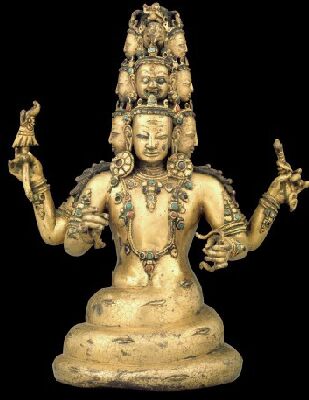The following have been published in various posts, with photo credits and other information not repeated here.
I. ANIMALS

17th-18 century, Tibet, Bardo figures, gilt copper alloy, published by Kapoor Galleries . A set of similar figures (possibly the same) including two wrathful gods has also been published on Christie’s
In Buddhist art, animals may be the main subject of a sculpture (main deity or attendant) or part of it, as a mount, the support of a throne, an ornament, an attribute held by a deity, a victim being trampled. Some deities have the head of an animal, or one of their head is that of an animal, or they wear the head of animal on their own or in their headdress, others wear the skin of an animal or sit on it.
ANTELOPE
In Tibetan sculpture, many figures are seated on an antelope skin on top of a lotus base, although it is often wrongly described as a ‘deer skin’ (see below).
Maitreya and some forms of Avalokiteshvara have an antelope skin over the left shoulder, usually knotted across the chest.
BAT
From a set of animal-headed figures held at the AMNH, this bat-headed deity is probably a dakini known as Ga-phong Dongma in Tibetan, whose attribute is a whip.
BEAR
The female entity Rikshamukha has the head of a bear. Pehar may ride a bear or a have the skin of a bear on his shoulders. Kshetrapala rides a bear.
BUFFALO/BULL
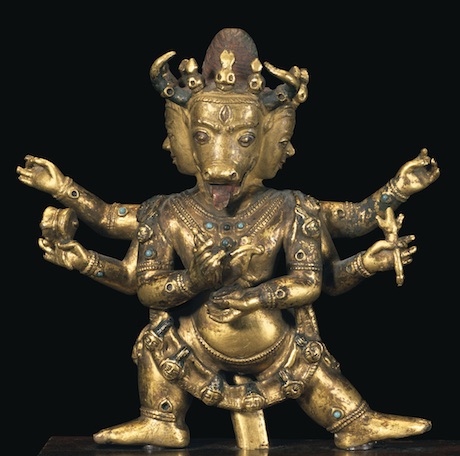
15th century, Tibet, Vajrabhairava, gilt bronze, private collection.
Vajrabhairava, most forms of Yama Dharmaraja, and minor deities have a buffalo head.
Yama Dharmaraja and various forms of Yamari stand on a prostrate male buffalo.
DEER
As an altar ornament, a pair of deer (male and female) is a symbol of fertility and happiness.

A single deer means renunciation.
Deities or historical characters are occasionally seated on the skin of a deer, whose horns are quite different from those of an antelope.
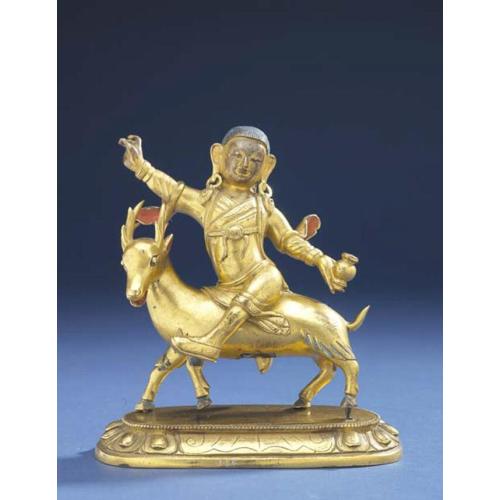
18th century, Tibet, yidam on deer, gilt bronze, at the Royal Ontario Museum (Canada).
Various entities ride a deer, including Chopen Drinzangma, one of the Five Sisters of Long Life, the Queen of Autumn, a Palden Lhamo retinue figure, and Vayu Deva, one of the Guardians of the Ten Directions and a medicine buddha retinue figure.
DONKEY/KHYANG
One form of Chakrasamvara is donkey-headed.
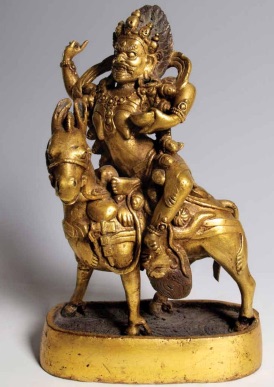
15th century, Tibet, Lhamo (Magzor Gyalmo form) gilt bronze, private collection.
Shri Devi rides a mule or a Khyang/Kiang, a wild ass from the Tibetan plateau, often referred to as a mule although it is much smaller.
DOG
Mahasiddha Kukkuripa is accompanied by a small dog.
The dakini Shvanasya has the head of a dog.
DRAGON
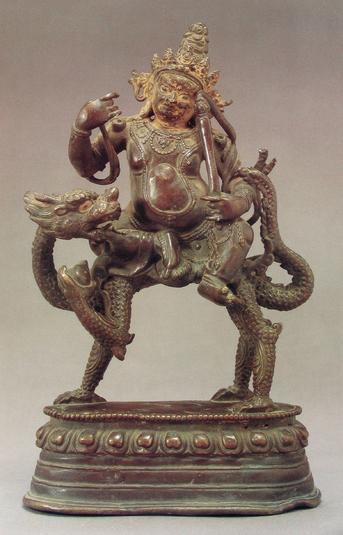
Unlabelled (circa 18th century?, Tibet?, copper alloy and cold gold), private collection, item 202902 on HAR.
One form of Jambhala rides a dragon.
The bhutadamara form of Vajrapani has a dragon in his headdress.
ELEPHANT
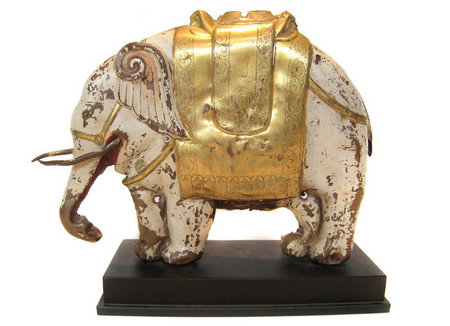
Queen Maya, mother of the historical buddha, dreamed that a white elephant entered her womb at the time of conception.
Shakyamuni and Akshobhya may be seated on a throne supported by elephants.
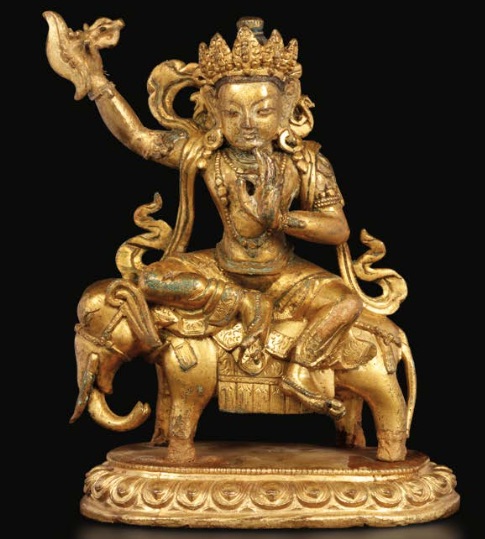
18th century, Tibet, Samantabhadra, gilt bronze, private collection.
the bodhisattva Samantabhadra, along with wrathful gods such as Pehar, Vighnantaka, and others may ride an elephant.
Vajrakila, the 12-hand form of Chakrasamvara, the 3-head form of Hayagriva, Dorje Rabtenma, a form of Yamantaka, and a few others usually have the hide of an elephant across their back. The one-head and six-hand form of Mahakala stands on Ganapati.

18th century or later, Tibet, Ganapati, bronze, private collection. Update 11/04/24: 19th or 20th century, photo here
Ganapati, also known as Vinyaka, is an elephant-headed deity of Hindu origin (Ganesha). In Tibet, he may be represented as a destroyer of obstacles, standing, with one head, two legs and two to twelve arms but..
… he is usually depicted as a victim (with two or four arms) lying on the pedestal, subdued by a wrathful deity. So is the minor elephant-headed deity referred to as Bhuta Aparajita, who lies on snakes and is trodden upon by the bhutadamara form of Vajrapani.
As an altar ornament, an elephant carrying a bowl of vermilion on its back represents the undisciplined mind.
FISH
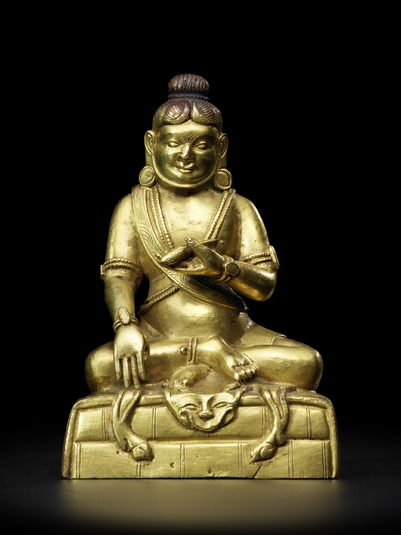
18th century, Mahasiddha Tilopa, Tibet, gilt copper alloy, private collection.
Mahasidda Tilopa and the dakini Gauri hold a fish.
GOAT
Dorje Legpa and Garwa Nagpo may ride a male goat, usually with twisted horns. Female deity Vajra Mahachagala is goat-headed.
HORSE
In Buddhism, the horse represents the wind, freedom and success. The Cakravartin has a wind horse carrying an eight-faceted flaming jewel on its back.
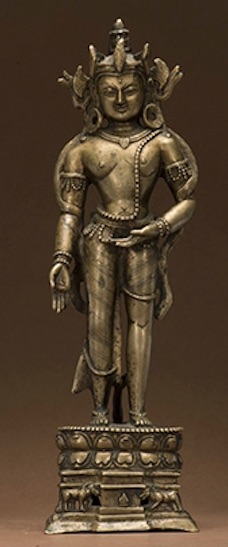
12th century, Western Tibet, Ratnasambhava, brass, private collection.
Ratnasambhava may sit (or stand, on this rare example) on a throne supported by horses.
Tsangpa Karpo and Dorje Ta’og ride a horse.
Hayagriva has a horse’s head, or three, on his own. A rare form of Avalokiteshvara and the guhyapati form of wrathful Vajrapani have the head of a horse on their own.
LEOPARD
Some characters and especially the consort of meditational deities wear the skin of a snow leopard as a loin cloth.
LION
The white snow lion with a turquoise mane is the national emblem of Tibet (snow and sky) and a local deity.
The lion is a symbol of the historical buddha, and snow lions may support the throne of Shakyamuni, Vairochana, Bhaisajyaguru.
Jnanadakini always sits on a snow lion. Vaishravana, Avalokiteshvara, Manjushri, and Tsongkhapa may be seated on a lion. Wrathful entities such as Pehar, Dorje Legpa, Guru Dragpo, Dorje Ta’og may ride this animal.
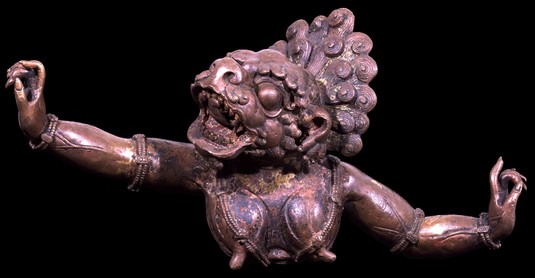
17th century, Tibet, Simhamukha, metal, at the Rubin Museum of Art in New York, (USA).
Dakini Simhamukha and Simhavaktra, one of Palden Lhamo’s attendants, have the head of a lion. Some wrathful deities wear its hide over their back.
Dakini Pukkasi holds a lion in one of her hands.
MONGOOSE
Arhat Bakula, Vaishravana, Dorje Rabtenma, Yellow and Black Jambhala, the Yaksha Generals, Karma Dakini hold a mongoose in their left hand. The animal usually disgorges jewels. Some historians believe this is due to the fact that purses were once made out of this animal’s hide.
PEACOCK
Amitabha/Amitayus may sit on a throne supported by peacocks.
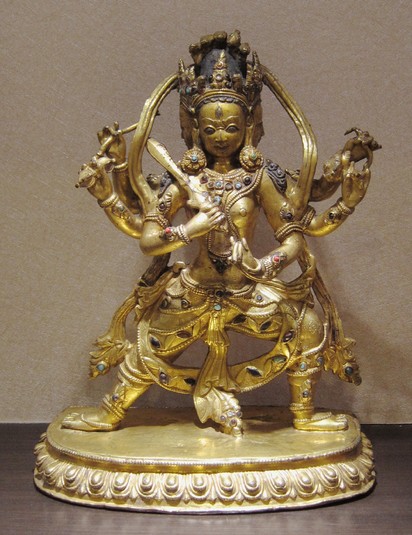
15th century, Tibet, Janguli, gilt metal with stone inlay, private collection.
Janguli wears a dress made of peacock feathers. Mahamayuri holds a peacock feather or a fan made of peacock feathers in one of her hands.
SCORPION
The hilt of Begtse Chen’s sword is shaped like a scorpion. Guru Dragpo/Dragmar holds one in his left hand.
SNAKES/NAGAS
Snakes (usually cobras) or nagas symbolise water, the underground, and unseen realms. These water spirits become furious when men show disrespect towards nature and they punish them with disease or calamity. This is why they also symbolise anger and are worn by wrathful gods (Vajrapani, Mahakala, Achala) in the guise of necklaces, bracelets, anklets and sometimes in their headdress or like a hood over their head (as above).
Rahula is half human and half snake.
Buddha Nagaraja and the shanglon form of Mahakala wear snakes over their head (naga hood). One of Magzor Gyalmo’s earrings is a snake, garudas hold a long snake in their beak, dakini Ghasmani holds one, Janguli holds one or wears it on her head or as jewellery, Guardian King Virudaka and wrathful deities such as Achala, Vajrapani, Krodha Vighnantaka are adorned with snakes in the guise of bracelets, anklets, necklace, sacred cord and ribbon for their hair, the mahacakra form of Vajrapani holds a snake in both hands. One form of Pehar has a snake skin over his shoulders. Wrathful deities often tread on victims lying over snakes. or directly on the snakes.
SOW/WILD BOAR

15th century, Central Tibet, Tsang province, Marichi, gilt metal with pigments and stones, private collection.
A female wild boar draws Marichi’s chariot. Marichi may be seated on a wild boar. In her three-head form, one or two of her side heads are the head of a wild sow. Vajravarahi may have the head of a sow but usually has a small sow’s head protruding from hers or on top of hers. Like her, Marichi and Pashadhari sometimes have the head of a sow on top of their own (or a sow-headed figure as above). Dakini Chauri holds a wild boar.
TIGER
Tigers represent strength and fearlessness. In Tibet, some aprons used for dance rituals imitate the skin of a tiger. Some characters are seated on a tiger skin atop a lotus base.
A tiger skin worn as a loincloth indicates a wrathful activity or symbolises control over anger. Most male deities with a wrathful appearance wear a tiger skin loin cloth. Pehar may wear the hide of tiger over his shoulders. Female deities Sardulamukha and Viagrasya have the face of a tigress.
Dorje Drolo rides a tigress and so does the vyaghravahana form of Mahakala.
Dharmatala and arhat Chudapanka may be accompanied by a tiger.
TORTOISE
Pedestals in North-Eastern India (Pala period) are often shaped what looks like a tortoise but represents a three-dimensional mandala. Dakini vetali holds a tortoise in one of her hands.
WOLF

18th-19th century, Tibet (Mongolia on HAR , Las Mkhan damar po, copper alloy and pigment, at the Ashmolean Museum in Oxford (UK)
The wolf is Lascan Dagmarpo’s mount and one of Pehar’s too. Begtse Chen’s son, the Lord of Life, rides a wolf.
II MYTHICAL CREATURES.
GARUDAS
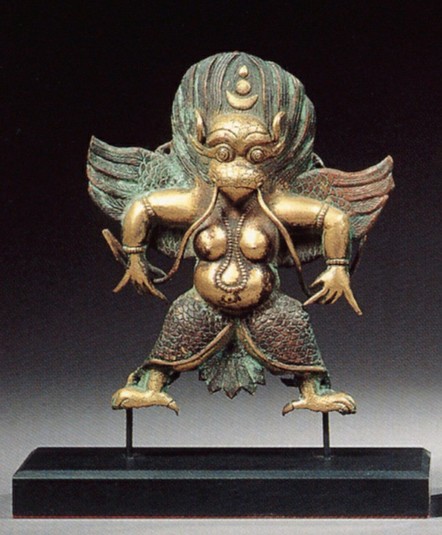
Undated, garuda, brass with pigments, on Himalayan Art Resources, item 20364.
Half man-half eagle, with two horns, the garuda is the enemy of the nagas (snakes) which he devours. In Tibet this creature is called khyung. In Nepal, and to a lesser extent in Tibet, a garuda often decorates the top of an arch behind a main deity (torana).
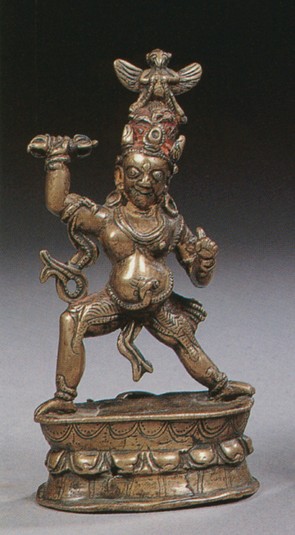
Undated (circa 12th century), Tibet?, Vajrapani, Guhyapati form, copper alloy and pigments, private collection.
Krodha Vajrapani may have a garuda in his headdress…
or on his pedestal.
The garuda is Amoghasiddhi’s mount, and his throne may be decorated with one.
KINNARAS
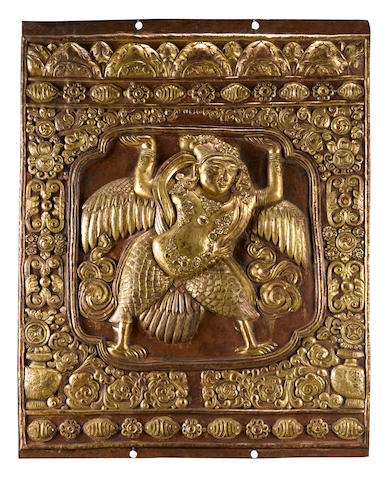
17th century, Tibet, kinnara, gilt copper alloy repoussé, private collection.
Kinnaras are celestial musicians. In the Himalayan region, they are half human (head, arms and sometimes torso) and half bird. These figures are used as decorative elements.
KIRTIMUKHA
Kirtimukha is often said to represent greed, this is why he just has a face (with vegetation coming out of his mouth) and two hands, but originally he represented the sky and was surrounded by clouds. In Nepal he is known as Chepu while in Tibet he is called Zeepata. In both countries deities often have a small effigy of Kirtimukha on the front panel of their crown, or a design derived from it.
He also decorates the top of flaming mandorlas, cushions, thrones, furniture and temples.
MAKARAS
Half elephant and half crocodile, the makara is a decorative figure seen on prabhamandalas and on top of buildings (like gargoyles). Their head is often on Tibetan teapots (as the spout) and on ritual implements (kilas).
Makaramukha is a makara-headed dakini and as such she wears a skull crown and stands in a ‘dancing pose’, one foot in the air, the other on the pedestal, sometimes over a victim. The above has a flayed human skin on her back and is adorned with bone bracelets and a cross-belt.
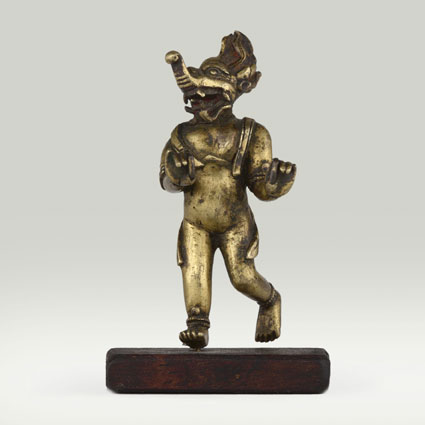
17th century, Tibet, Makaravaktra, brass, at the Tibet Museum in Gruyères (Switzerland).
Makaravaktra is one of Palden Lhamo’s attendants.
NAGAS
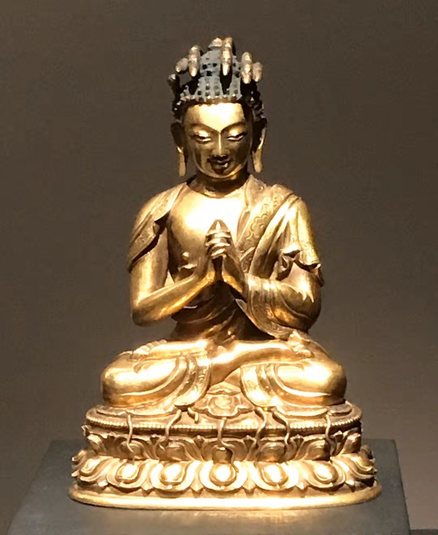
16th century, Tibet, Nagaraja, gilt metal, private collection.
Nagas are snakes. They sometimes form a hood over a figures’s head (such as buddha Nageshvara, Indian teacher Nagarjuna).

15th-16th century, Central Tibet or Nepal, nagaraja, gilt copper alloy inlaid with gemstones, at the Virginia Museum of Fine Arts (USA).
Naga kings (nagarajas) are often depicted half kneeling half crouching, bedecked with princely jewellery, with a hood of 5 to 7 cobra snakes.
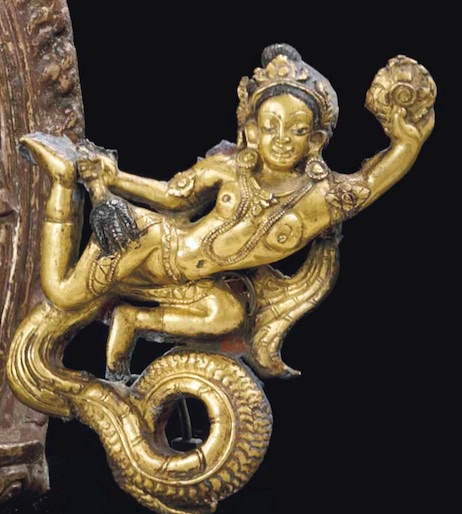
15th century, Tibet, nagini, gilt copper repoussé, private collection.
Their female counterpart are naginis.
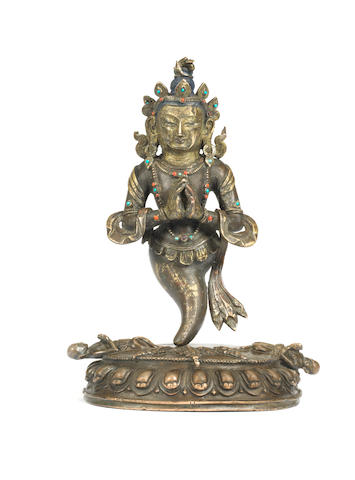
18th century, Tibet, Naga king Karkota, bronze, private collection, photo on Bonhams
SHARABHAS
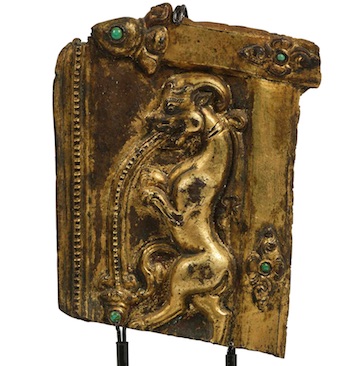
15th-16th century, Tibet, Sharabha, gilt copper repoussé, private collection.
In Tibetan buddhism, a Sharabha is a beast generally depicted with the body and legs of a horse, the head of a goat, the horns of a goat, an antelope or a ram, the mane of a lion, and sometimes the claws of an eagle. Nepalese and Tibetan prabhamandalas often include a boy seated on a sharabha on each side of the arch.
VIYALAS
A viyala, vyala or vidala may be half lion-half horse …
or half lion-half griffin (leogryph). Viyalas are used as decorative elements – especially on prabhamandalas, instead of the sharabhas.
YAKSHAS
Yakshas are ancient Indian nature spirits associated with tree worship.
In Himalayan sculpture, they are often depicted like dwarves with shoulder-length hair supporting a throne with their head and hands, and usually flanked by two snow lions. They may sit in the vajra position or crouch.
When depicted as the main subject, they often have a beard and a fat belly.
Many wrathful deities in the Tibetan pantheon have the appearance of a yaksha (or a yakshi).


























